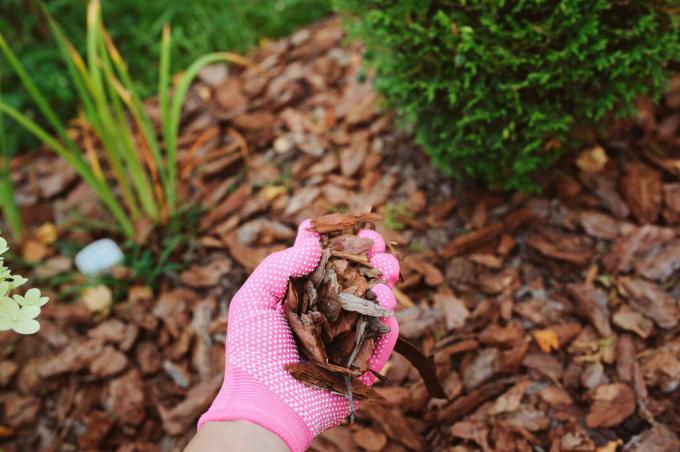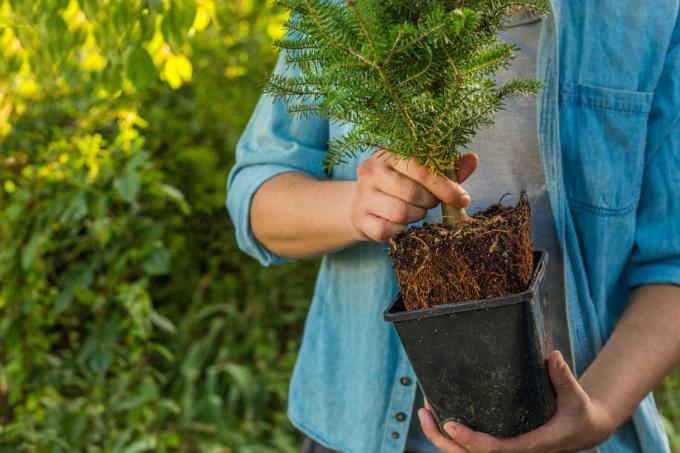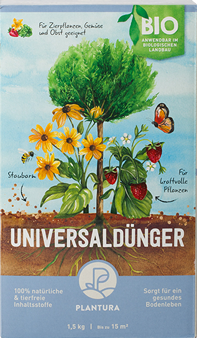We have put together for you here what you can do with the various components of your Christmas tree and how to plant it properly.
Every year spruce (Picea), fir (abies) and pine (Pinus) just in the garbage after the holidays. But that doesn't have to be the case: give your Christmas tree a second life after its faithful service. In fact, with a few tips and tricks, almost every Christmas tree can be recycled and at the same time protect the environment. If you have already decided on a Christmas tree with roots in a pot, you can simply plant it out and it will lead a happy life in the garden for years to come. But even trees that have been felled are far too valuable to simply be disposed of: numerous useful household helpers and decorative objects can still be made from them. Here you can find out how you can use your Christmas tree sensibly even after the holidays.
contents
-
Recycle Christmas Tree: New uses
- 1. Bath additive with healing properties
- 2. Spruce and pine needles as a tea
- 3. Snail defense without chemicals
- 4. Turbo for the compost
- 5. Frost protection and mulching
- 6. DIY material
- 7. Cozy warmth from the oven
- Plant out the Christmas tree
- Properly dispose of the Christmas tree
Recycle Christmas Tree: New uses
All sorts of things can be made from a disused Christmas tree, even if it doesn't seem like it at first glance. Here we explain various ways in which you can recycle your Christmas tree.
1. Bath additive with healing properties
Especially in the cold winter, a nice full bath is a real blessing: you can simply relax in the hot water and let your soul dangle. In addition, such a hot bath can help with all sorts of complaints such as colds and tension. But what does that have to do with your Christmas tree? Quite simply: the essential oils of spruce, fir or pine have an expectorant and relaxing effect and are therefore an ideal bath additive. Boil about 100 g of the needles in water for ten minutes and pour the brew through a sieve into the full bathtub - a great cold and relaxation bath is ready.

2. Spruce and pine needles as a tea
Spruce and pine needles not only have a healing effect as a bath additive - the two plants also work wonders as a tea. Due to their high vitamin C content and essential oils, a tea made from their needles is excellent for combating cold symptoms and spring tiredness. For a cup of tea, cut up about a teaspoonful of pine needles, put them in the cup (if there is no sediment If you want, you can of course put the needles in a filter paper or tea strainer beforehand) and fill the cup with hot water on. After the tea has steeped for about ten minutes, it is ready to be consumed.

3. Snail defense without chemicals
The old Christmas tree can not only be useful in the house, spruce, fir or pine can also start a second life in the garden. Their needles, for example, are considered an old one Home remedies for snails. To do this, simply keep the needles of your Christmas tree in a dry place and scatter them around plants that are particularly vulnerable to snails in spring. Since snails are very reluctant to crawl over the prickly needles, they will prefer to avoid it. In this way, the Christmas tree helps in its second life to keep the garden free of snails without any chemicals.

4. Turbo for the compost
Anyone who composts their organic waste themselves has certainly been tempted to dispose of their old Christmas tree there. In fact, the branches of the coniferous tree on the compost are a real blessing because they ensure better composting. The reason: While kitchen waste (which makes up most of the compost in winter) is very soggy, the large branches and leaves of the Christmas tree provide more structure and thus a better one ventilation. This accelerates the decomposition and the old kitchen waste can be composted more quickly. But the Christmas tree also ultimately benefits from the kitchen waste - because this ensures that that the dry branches are moistened again and the decomposing organisms work faster be able.

5. Frost protection and mulching
How about a second life as a hero of the weak? This dream can come true for the Christmas tree. After all, fir branches have always been a well-known household remedy to protect sensitive plants from the freezing cold and fresh wind in winter. Flower bulbs and perennials that sprout particularly early benefit from such a help: If you put them Fir branches in several layers flat on the bed, they reliably protect the sensitive young plants frost off. Mulch, which can be made from Christmas tree branches, also protects against the cold. To do this, simply shred the twigs to a length of about 4 cm - if this is too strenuous by hand, you can rent a shredder from most hardware stores. Generously distributed in the bed, this mulch layer not only provides frost protection, but also provides the soil with new ones Nutrients, reduces the evaporation of moisture and also keeps weeds from growing - a real all-rounder.

6. DIY material
Are you a passionate hobbyist and do-it-yourselfer? Then with your Christmas tree you have the perfect starting material for new decorations or even new furniture. Conifers are particularly suitable for beginners for handicrafts, as they are much softer than oak or beech, for example, and are therefore easier to work with. Among other things, a great clothes stand can be built from the old Christmas tree. The branch axes serve as hooks so that coats, jackets and bags can be hung up on different levels. If the trunk and branches are also peeled, sanded and, for example, whitewashed, the old Christmas tree becomes a stylish looking piece of furniture. You can also use the thicker branches to make wooden buttons for homemade clothing. Simply saw off a few tree slices and remove the bark. With sandpaper you can now bring everything into the right shape and then add holes. Finally, you should just rub the whole thing with vegetable oil and let it dry. The individual wooden buttons are ready.

7. Cozy warmth from the oven
The owners of a fireplace or an oven have it particularly nice in winter: With cozy warmth, gentle crackling and a cozy atmosphere, such a fireplace also sweetens the dark season. Of course, the disused Christmas tree is also wonderfully suitable as fuel - sawn into pieces suitable for the stove, it supplies the fireplace with supplies for its warming fire. However, pay attention to the residual moisture content in the wood: Depending on how long the tree was in the house, it may still have to dry. The residual moisture content in the wood should always be below 20 percent, otherwise there will be a lot of smoke and the chimney will become sooty. If the wood is still too damp, it is better to store the cut pieces in a dry place for a while.

Plant out the Christmas tree
If you don't want to simply throw your Christmas tree away after the party, you can decide on a Christmas tree in a pot when you buy it. Many sellers are now also offering their trees with root balls, so that you can simply plant out the fir, spruce or pine again after Christmas. But caution is advised when buying: Many trees are only pricked and put into the pot shortly before the sale. This often damages the root ball and makes growth in the garden much more difficult. Therefore, before buying, check the strength of the root ball. If this crumbles, there is a high probability that the tree has been cut out and will not grow well in the garden. You should also refrain from the famous Nordmann fir. Since these only form taproots that reach deep into the earth, it is species-appropriate growth not possible in the pot - the tree will therefore most likely die after planting out.
Once the Christmas tree is in the house, special attention should be paid to the right care, because only a healthy tree can be planted out later. The most important thing is choosing one high-quality potting soil for the plant: Even if conifers are considered to be quite undemanding in nature, good potting soil can significantly increase the chance of successful planting. On the one hand, high-quality soils already contain (depot) fertilizer, which supplies the Christmas tree with sufficient nutrients so that additional fertilizer does not have to be added. On the other hand, the soil structure is better, so that the irrigation water can be stored well. It is best for the Christmas tree if it is left in the warm living room for as short a time as possible. You should also make sure that you have a good water supply: you have to water it about every two days so that the bale does not dry out. Spraying the needles with water helps prevent them from falling off due to the dry heating air.

If the tree survived Christmas well, it's time to prepare it for its second life: setting First put it in a cool, but frost-free place so that it can slowly get used to the climatic conditions can. Nevertheless, the Christmas tree should continue to be watered, even if not quite as often as in the warm apartment. After about 14 days he can finally move into the garden - as long as the weather permits. At temperatures below freezing, it is advisable to keep the tree indoors for a little longer. Loosen the soil at the desired location and mix in compost or a slow-release fertilizer like ours Plantura organic universal fertilizer with it, so that the tree is initially supplied with sufficient nutrients. When stuffing, pay special attention not to damage the delicate roots of the Christmas tree. A thick layer of mulch can also protect the sensitive roots from cold and drought - so your Christmas tree can grow and thrive in peace.

Plantura organic universal fertilizer
effective long-term effect,
good for the soil, harmless for humans, animals and nature
Planting out a Christmas tree: summary
Do you want your Christmas tree to grow into a stately conifer in the garden? Here you will find a summary of all the steps from purchase to planting.
- Pay attention to root quality and variety when buying
- Supply the Christmas tree in a pot with high-quality potting soil
- Leave it in the warm apartment for as short a time as possible
- In the apartment, water every two days and spray needles with water daily
- Allow to acclimate for about 14 days in a cool but frost-free room before planting out
- Only plant out in a mild climate
- Loosen the soil well and mix with hummus or compost
- Be careful not to damage roots when tamping
- Spread a layer of mulch to protect against cold and drought
Properly dispose of the Christmas tree
If you don't have the time or desire to recycle your Christmas tree, you don't have to have a guilty conscience: there are now many good offers and opportunities where you can easily dispose of your Christmas tree, but still give it a second life allows. Wild animal enclosures, zoos, forest rangers or equestrian facilities often gratefully accept the old Christmas trees. Here the trees are used to feed and occupy the animals and thus serve a good purpose.

However, you should make sure that the tree is fully decorated and has not been chemically treated. Some organizations such as rural youth or scout groups even pick up the trees for a small donation right on your doorstep. While the money flows into various aid projects, the trees are kept for the next Easter bonfire, where they provide warmth and comfort.
If you don't have a zoo nearby or an organization that accepts the trees, you should It is best to take your old Christmas tree to a recycling center or a green waste collection point hand over. Here the fir trees are usually chopped up and composted. Under no circumstances should you dispose of your Christmas tree in the nearest forest: not only the trees decompose extremely slowly, and there is also a risk of a hefty fine of up to 100 euros per tree.
If you want to save on recycling the Christmas tree and are interested in a more sustainable alternative, our article on Christmas tree in a pot find it.
...and receive concentrated plant knowledge and inspiration directly in your e-mail inbox every Sunday!

